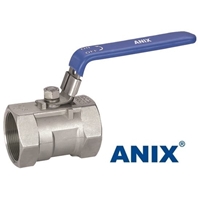By: Lauryn B.

Check out https://anixusa.com/stainless-steel-ball-valve for Anix Valve USA's wide range of wholesale ball valves.
What is a ball valve?
Have you ever gotten confused about which is the right valve for the task at hand? Frustrated and confused since there are so many of them? Or even wondered what they are used for? Well we are going to talk about one specific value today, the ball valve. What a ball valve does is it controls the flow of liquid and/or gas, by having the ball revolving around the bore. When rotating the lever 90 degrees, the internal ball will allow the liquid or gas to either stop or flow. The ball valve is deemed as the most popular valve to use.
Fundamentals of ball valves
There are 5 main ball valve parts and 2 different operation types. The valve stem is connected to the ball and is supported and sealed by the ball valve seat and there are O-rings around the stem. Everything is sealed inside the valve housing. The function of the valves and all operations (manual or automatic) are what keeps the gas and water flooding through or stopping it.
Circuit function
There are various ports, which can range from 2 to 4. Most ball valves have 2 ports with a manually operated lever function. When the valve is closed it is aligned with the pipe, when turned, it is perpendicular to the pipe. Valves that are manually functioned are quick to close, but there is a risk of water flowing through the media. Ones that have 3-way ports tend to be shaped like an L or a T shape. This could result in getting mixed flows, with air and/or water flowing through simultaneously.
Valve materials
There are different types of materials used for manufacturing valves, but some materials have more distinctive uses. Brass ball valves are used for water, gas, oil, air and many other media. Stainless steel valves are used for corrosive media and aggressive environments, like seawater, swimming pools, osmosis installations, with high temperatures, and many chemicals. PVC valves are cheaper, but they're usually used for irrigation, water supply and drainage or corrosive media. The materials that house the ball are made out of brass, stainless steel, or pvc (polyvinyl chloride). Usually the ball is made out of chrome plated steel, chrome plated brass, stainless steel, or pvc. The seats of the valves are made out of teflon but it could also be made out of manufactured materials or metals.
Why are ball valves more popular?
They are more popular since they are more durable, perform well during cycles, more reliable, and are more secure when closed for long periods of time, even in disuse. They are usually popular for shutoff applications. They are also popular since there are so many material options, and you have options to pick for the right job. They are also pretty easy to clean, since the ball inside the valve self cleans itself. By having the ball rotate the seat, it wipes itself and doesn't cause any build up. It has no internal components, and therefore lacks maintenance. They are also very easy to monitor. They can even be used for a differing area of applications. The best part is that it is worthwhile and reliable.
